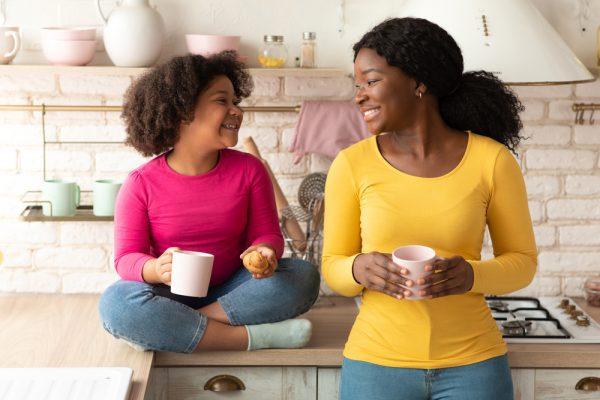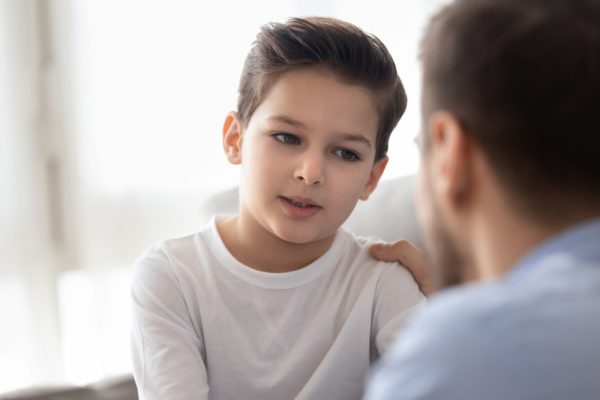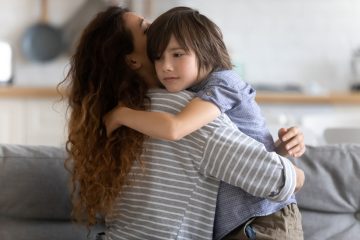
Beginnings and endings are useful milestones to help us mark the passage of time and the necessary transitions we all face from old to new throughout our lives. But each beginning and ending can come with its own set of emotions and challenges — excitement, sadness, nervousness, determination, change, anxiety, opportunity. This summer, many families are experiencing a series of beginnings and endings all at the same time, as COVID restrictions ease, kids say goodbye to what may have been a strange and unsettling school year, and everyone tries to prepare for what’s next. We talked to Drs. Juliana Chen and Tai Katzenstein from The Resilience Project at Newton-Wellesley Hospital to find out how parents can talk to kids about the changes, and how to plan together for a successful transition period.
What resilience really means for families
You’re resilience experts! We keep telling families that this was, and is, a moment to build resilience, but do you think most parents even know what that really means — or are able to connect to that concept? Is it asking too much or adding to families’ loads to keep pushing the resilience message?
Juliana: We talk about resilience. We believe in it. But it’s not the way most families think. No one wishes for difficult times, and resilience is often built during the harder times. Sometimes when you’re talking about resilience, it can feel invalidating of people’s lived experiences and real challenges.
Tai: Just trying to survive and get through.
Juliana: Right. No one wants to hear, “On the bright side, you can build resilience!” Kids and teens are not motivated by this message. We know this is true, this can happen in every family, kid and teen, but it can be a complicated message to give.
Tai: Juliana and I are huge fans of self compassion. A first step is to not be overly critical. There’s a tendency all around us to ask: “Have you taken advantage of the pandemic to spend quality time?” We’ve survived and gotten through however we’ve survived and gotten through, and we should celebrate that. This has been hard for everyone, and we’ve all done the best we can to get through.
Also, it’s important to get that it’s never too late. Resilience is a process, not an outcome. We build it in childhood, adolescence, adulthood, late adulthood. It’s not that this was the one opportunity. It’s always there to be practiced and strengthened. Scenarios that come up all the time offer us the opportunity. There are lots of ways to understand what resilience is — in certain times it’s about really great self-care, or really great communication, or reframing failure. The great thing is we get to keep practicing and trying it and it’s in that practice over time that we strengthen those muscles.

How to communicate with kids and teens
Let’s focus for a minute on what you just brought up: The idea that self-care or great communication can actually be connected to resilience. Most people don’t think of resilience that way. They might not know what it means to use communication as an act of resilience, or that when they practice good self-care, they’re building resilience. Can you talk more about that idea?
Juliana: Resilience begins with the basic stuff people know is good for us, and yet we often dismiss it — parents, especially, because they’re busy taking care of everyone else. The basics of good sleep, healthy nutrition, getting outside, connecting with loved ones, really matter. The pandemic was a strong reminder of how important these things are. They’re the foundations of our emotional and mental health. Being able to be kind, patient, and loving with ourselves — all these basics serve as critical models for our kids and teens, who are learning the basics of self-care and compassion for themselves.
Tai: I think part of why we think about communication as another bedrock of resilience is that, both for ourselves and for our kids, part of how you manage through difficult times is that you learn how to manage holding difficult and hard-to-feel feelings. And part of the way kids learn to do that is through communication with parents, and part of how parents learn to do that is through communication with people around them. There are as many definitions of resilience as there are people focusing on it, but for us, communication is a huge piece.
We like to talk about what we call the 4 Cs. It’s a framework for how to think about communication in general, or when there’s something hard to talk about. The first C is Calm, where we encourage parents to really be aware of where they are emotionally. We don’t want to engage in conversation when we’re dysregulated. We all know this in theory, but how often do we disregard it? Take your own temperature before you step into a conversation, and don’t step in unless you’re relatively calm.
The second C we talk about is Curious. For parents, the goal is to try to hold back from jumping in and problem-solving first, and instead we try to understand what’s going on for our kids. What are they thinking and feeling? What’s their perspective? We want to fix things right away, but the idea is to hold back and get our kids to think first on their own, to practice reflecting, articulating and staying calm enough to explain it to us. We need to stay curious about what their thoughts and feelings are. If there were a bumper sticker for this step, it would be “Talk Less, Listen More.”
Juliana: From there, we go to Compassionate. The Compassion really goes alongside the Curious, so as you’re talking less and listening more, you’re bringing your whole heart to what you’re hearing and your kid is sharing with you. Maybe we don’t get what they’re feeling, or we don’t think it’s such a big deal, but it’s so important to your kid. It’s critical to make space and to bring real compassion for what they’re going through and feeling.
This brings us to the final C, which is Concerned. This is where parents usually start the conversation, where they’re saying what they’re thinking about or telling kids what they need to do, and that’s a mistake. For teens and tweens, this is the step where they more often shut parents out, so parents really need to do the other Cs first. We know it’s not this simple, but when a child or teen is feeling heard and supported, it allows them to feel a sense of safety, to build their own communication skills, to reflect on what they’re thinking and feeling and to practice the early steps to problem solving. These are all critical parts of resilience. It also helps them be a little more open to listening and hearing what a parent’s perspective might be so parents get a lot of mileage out of prioritizing the other Cs first.
You know, as Tai and I talk about resilience, we want to be really careful for parents not to feel like we’re adding another responsibility or task onto their plate or another way that they need to live up to a standard or expectation. Yes, this is a pandemic and this is a capital O Opportunity to practice, but really resilience is built in the daily microinteractions, just as parenting is in the daily microinteractions. Supporting our kids’ resilience building is not intended as an extra to do, but more a perspective on how you’re approaching the ins and outs of daily life so it doesn’t feel so overwhelming. It’s just wrapped into the day-to-day.
Tai: Exactly, it’s not this thing you have to do in addition to everything you’re doing. It’s already in the interactions around turning off screens, getting dressed, setting the table or a school grade that went bad. It’s already happening 24 hours a day, so it’s having the awareness and intentionality around the opportunities to bring some of these ideas in — with full self compassion for the reality that we’re not going to be able to do it every time. We have this thing called Repair when we screw up. We can always Repair. And opportunities are plentiful.
Juliana: Also, some overarching things we talk with parents about that support resilience: Trying to occupy a space of unconditional love when you’re approaching kids and teens. It can be helpful to take a moment to intentionally notice that space. Keeping compassion as a backdrop of everything you’re doing: compassion for your kid, and compassion for yourself. And remembering the idea of good enough parenting, that resilience is built over time. It’s not a make or break. There’s room for disappointments and mistakes, even in our parenting, and we have to extend that compassion to our kids, too. There’s room for good enough. Keeping these larger themes in mind can shift where a parent’s headspace is to help shift our parenting approach and help support resilience building in our kids and teens, and ourselves.
How to create a home environment that supports communication
 Okay, so we know that whether or not families FEEL like they’re building resilience, they probably are, in one way or another. And you’ve given some great advice for parents about how they can talk to their kids in a resilience-focused way. What else can parents do at home to set up an environment that’s supportive of all they and their kids are going through during this transition?
Okay, so we know that whether or not families FEEL like they’re building resilience, they probably are, in one way or another. And you’ve given some great advice for parents about how they can talk to their kids in a resilience-focused way. What else can parents do at home to set up an environment that’s supportive of all they and their kids are going through during this transition?
Juliana: At the risk of sounding redundant, a lot of the same messaging and approaches apply. Thinking about the larger family, making room for feelings, and maybe explicitly talking about transitions as a family — these are things we really believe in. Family meals are a great ritual and a wonderful time for families to come together and talk explicitly about feelings, what’s working and not working. We’ve advocated this since the beginning of COVID, and now as we are all navigating yet another transition, it can still be helpful to talk about what’s working, not working, how is the transition going, while making room for wide ranging reactions, feelings, and comfort levels.
Tai: Family conversations could also include a little bit of education about what a transition is, how long it can take, how it can feel “We are in this in-between period, and this is how we’re going to be tracking how it’s going.” Making it talk-aboutable is important.
As a family, knowing that we’re going to be flexible and try something, and then talk about it down the road and try again — that’s modeling for the whole family how resilience and problem solving works. Transitions are hard, but as a family there are ways to focus on the positive, to find joy and find things to be grateful for, like using the Rose, Bud, and Thorn activity from the Family Dinner Project. Talking about things like patience and generosity — these things matter. They’re also important parts of resilience.
How to get kids to talk to you (or not!)
You know, it’s interesting. We certainly have a lot of ideas for families, and a lot of conversation starters to help get the ball rolling. But we hear so often from parents, especially parents of tweens and teens: “Oh, my kids won’t answer that. Oh, my kids don’t talk to me about anything. If I ask them any of these, they’ll just roll their eyes.” And here you’re talking about the importance of communication, and the importance of making things “talk-aboutable.” So what can parents do if they’re in one of these relationships with kids who are just not ready to embrace communication?
Tai: This is so common, especially with parents of teens. One of the things, up front, is to be thinking about troubleshooting. Teens don’t talk for a number of reasons, and communication can be strained for any number of reasons. I would be curious: What’s making communication really difficult? Is it the topic, or is there relationship strain? Are there certain communication or emotional regulation skills that make the communication hard? The first step is to identify what makes it hard.
Juliana: Also, has it always been this way? Some kids lean quiet or private. But is it something new? Taking into consideration the context really matters.
Tai: It can be helpful for parents to understand that communicating with teens often can look really different. Try opening up what it means to communicate. Sometimes communication happens through words. Sometimes it’s nonverbal. It could be doing a version of parallel play, letting your kid teach you their favorite video game or watching a movie together. That’s a valid method of communicating and being together. Maybe conversations only last one or two minutes. Maybe it’s ok for a teen to say “nothing” or “I don’t know.” Remembering normative adolescent development and shifting the frame for what communication looks like can be helpful.
Juliana: Tai and I talk with parents about being intentional about when they are opening conversations and trying to connect. Is there a better time of day to catch your kid or teen, a quieter moment where you might catch them being more open and willing? Is there something they really enjoy that you can connect over, being curious about their world, their video game, their TikTok? Really tuning into your individual kid and following their lead on what communication looks like. Parents may not realize they have a certain expectation of what communication should look like.
Tai: One of the most important things is for our kids and teens to know they can come to us when they need us, so we want to keep lines of communication open, but that doesn’t mean that we always have to be talking.

How to communicate when kids and teens are struggling (and how to know if there’s a concern)
That idea — that you can communicate with your children without having to feel pressured to talk — is a game-changer. I’m going to tuck that into my back pocket and remember it next time one of my kids insists on only interacting through dog memes. Seriously, though, this is a crucial idea for parents, especially given all of the recent focus on how fragile our kids’ mental health might be right now. You mentioned this before; some kids may have come through COVID fine, or maybe they’re just seeming like they’re fine on the surface. And some kids are really struggling. The best way for parents to know how kids are doing is to communicate, obviously. What other advice would you give?
Tai: Of all the age groups, tweens and teens have had the hardest time, because their developmental needs are diametrically opposed to what the pandemic has allowed. It’s been exactly the opposite of what they’re developmentally needing.
When teens are struggling, we need to be listening a lot and paying really close attention to our teens’ moods and behaviors. Anxiety and depression can manifest in a lot of ways — teariness, moodiness, explosiveness, perfectionism. Be aware of the myriad ways they can manifest.
Parents sometimes say they don’t want to bring things up because they don’t want to give kids ideas or make things worse. We have to make things talk-aboutable to relay observations and concerns. Be thinking about where your teens are now, at this point in the pandemic, and be thinking together as a family about: What are our expectations for re-entry? What is realistic in treating this re-entry piece from the perspective of knowing our kids, and being mindful that we’ve been through a trauma?
The pull to get back to normal can feel really good, and in some cases it’s easy to forget, but we want to be really mindful of what kids have been through, and try to set them up for good caretaking and support.
Juliana: Parents using the 4 Cs can be helpful, as we’ve said, since it can often be hard for parents to know how teens are really doing. Related to this, I want to mention the parent piece. Yes, rates of anxiety and depression are up, but as parents are thinking about their kids and teens’ mood, behavior and mental health, we want to encourage parents to tune into their own emotional state and level of worry.
Are you someone who leans towards worry? Are you parenting from a place of fear? How much of your concern is reality-based? Are you taking care of yourself? This is where self-care and self compassion really come into play. We do expect some regression in re-entry and yes, some kids are struggling, but many are not. We want parents monitoring, but we don’t want to escalate worry unnecessarily.
One piece of advice we often share is to never worry alone. Check in with your kid or teen. If you’re in a two-parent household, talk to your partner. Connecting with your child’s summer program or school, learning about what they’re seeing, or connecting with camp counselors, coaches, and other important people in your kids’ lives. Get a sense of what others are seeing with your child. There are mental health supports if you do feel that there’s a genuine concern, or if you’re not sure, connect with your pediatrician as a first step. They can help you to assess if there’s a bigger worry. Just as we wouldn’t want our children to worry alone, we don’t want parents worrying alone either.
 Great Back-to-School Questions for this Fall
Great Back-to-School Questions for this Fall
This has been a great conversation. To close, I wanted to ask about back-to-school conversations. We often circulate a list of good back-to-school questions parents can ask, to help them avoid “How was school?/Fine. What did you learn?/Nothing.” If you could make a short list of great back-to-school questions parents should ask in the Fall of 2021, what would that list be?
Juliana: There are no magic questions — if only it were that easy!
Tai: It’s true. Here are some ideas to get conversation started, but mostly we encourage parents being open and curious and really listening to whatever our kids and teens are sharing. Just being curious and listening can open more doors.
- How do you feel about going back this year? Do you think it will feel like a normal school year?
- What do you think will be the same? What do you think will be different?
- What are you most nervous about this school year? What are you most looking forward to?
- Who are you most excited to see or not see? Why?
- What are you most excited to do or not do? Why?
- What things do you think you’ll miss about remote learning?
- What will you miss the most about last year? What were your most favorite and least favorite memories from this last year?
- Do you think I’ve changed or our family has changed because of COVID? What’s new or different about me/us?
- If there was one thing you could continue from COVID life, what would it be and why?
- What are your top three wishes for this school year?
